Ruth Ellen Gruber's Blog, page 13
November 26, 2011
Prague -- Pinkas synagogue to be open tomorrow to commemorate deportations to Terezin
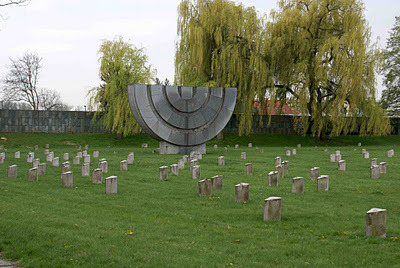 Monument at Terezin. Photo (c) Ruth Ellen Gruber
Monument at Terezin. Photo (c) Ruth Ellen GruberBy Ruth Ellen Gruber
As part of commemorations marking the 70th anniversary of the first deportations of Czech Jews to Terezin, the garrison town north of Prague used as a ghetto-concentration camp, the Pinkas Synagogue in Prague -- now a memorial to nearly 80,000 Holocaust victims in Bohemia and Moravia, will all names inscribed on its walls -- will be open free to the public on Sunday Nov. 27.
Published on November 26, 2011 10:26
Czech Republic -- a Zionist take on touring Jewish Prague
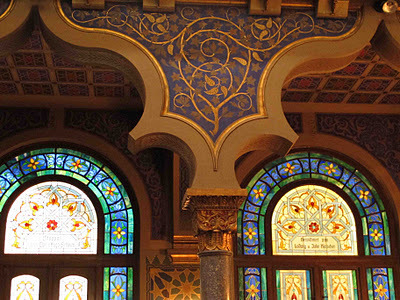 Inside the Jubilee Synagogue, Prague. Photo (c) Ruth Ellen Gruber
Inside the Jubilee Synagogue, Prague. Photo (c) Ruth Ellen GruberBy Ruth Ellen Gruber
There's a detailed travel story in the Jerusalem Post by Stewart Weiss about his visit to Jewish Prague. Prague has been visited and toured and written about so much that it's really hard to find a way to say anything new, or really to express any new emotion about it, its Jewish history, the impact of visiting Jewish sites and remembering both pogroms and the Holocaust.....I packed a lot of it in in my chapter on Prague in my 1994 book Upon the Doorposts of Thy House, including a critique of mass tourism....
Weiss article goes over much of the same material. He is ever-skeptical at the tour guide spin (though as a tour leader himself, he must know how to keep his audience.....).
The first stop on our trip is the ancient Jewish cemetery in the heart of Josefov, the Jewish Quarter. Because the land allotted to the Jews was woefully insufficient to bury their dead, there are at least seven layers of graves lying deep beneath the surface, where as many as 100,000 people are buried. But while the graves are invisible, the tombstones are ubiquitous, and stretch as far as the eye can see. They stand as silent, solemn witnesses to the past 1,000 years, from the time Jewish settlers first came to Bohemia, and they testify to a nation within a nation that included every conceivable vocation, from salesman to seamstress to scholar.It is strange to me, though, that in what he calls "four days of walking with ghosts" he seems to have totally missed the lively local Jewish community and local Jewish life -- writing only that Chabad "struggles valiantly to provide a working synagogue."
The greatest of these scholars was Rabbi Yehuda Loew, the famed Maharal of Prague (1525-1609). In lesser intellectual circles – and certainly among the tour guides peddling fantasy to wide-eyed visitors seeking same – he was the progenitor of the Golem, a clay figure brought to life in order to protect the downtrodden disciples of the Maharal.
Read full story HERE
Published on November 26, 2011 01:36
November 19, 2011
Art -- Sotheby's auctions Chagall (and Moyse) paintings of synagogue interiors
By Ruth Ellen Gruber
In its upcoming auction Dec. 14 of Israeli and International art, Sotheby's will be auctioning three rare large oil paintings from 1931-35 by Marc Chagall showing interiors of synagogues, and also two paintings showing synagogue interiors by the 19th century French painter Edouard Moyse. The paintings all come from the collection of a descendant of the art collector Max Cottin who acquired the Chagalls in 1945.
Chagall's paintings include a 1935 oil on canvas work showing the interior of the now-destroyed Kloyz of the Vilna Gaon in Vilnius, as well as two paintings of synagogues in Israel.
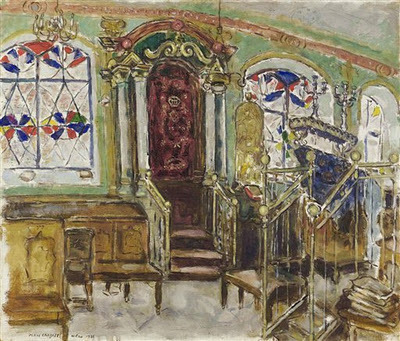 Chagall's 1935 oil of the Kloyz synagogue in Vilna. Photo courtesy of Sotheby's.
Chagall's 1935 oil of the Kloyz synagogue in Vilna. Photo courtesy of Sotheby's.
as well as
In its upcoming auction Dec. 14 of Israeli and International art, Sotheby's will be auctioning three rare large oil paintings from 1931-35 by Marc Chagall showing interiors of synagogues, and also two paintings showing synagogue interiors by the 19th century French painter Edouard Moyse. The paintings all come from the collection of a descendant of the art collector Max Cottin who acquired the Chagalls in 1945.
Chagall's paintings include a 1935 oil on canvas work showing the interior of the now-destroyed Kloyz of the Vilna Gaon in Vilnius, as well as two paintings of synagogues in Israel.
 Chagall's 1935 oil of the Kloyz synagogue in Vilna. Photo courtesy of Sotheby's.
Chagall's 1935 oil of the Kloyz synagogue in Vilna. Photo courtesy of Sotheby's. as well as
Published on November 19, 2011 04:31
November 18, 2011
Slovenia -- Exhibit in Maribor About Jewish WWI soldiers
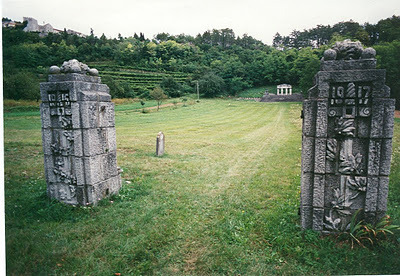 World War I Military Cemetery, Stanjel. Photo (c) Ruth Ellen Gruber
World War I Military Cemetery, Stanjel. Photo (c) Ruth Ellen GruberBy Ruth Ellen Gruber
Back in the 1990s, when I was documenting Jewish heritage in Slovenia, the most impressive site visited was the haunting remains of an Austro-Hungarian World War I military cemetery. All that was left were the massive stone pillars of the gates, a huge temple‑like monument, and about five scattered grave markers. Two of these were of Jewish soldiers, each bearing a star of David.
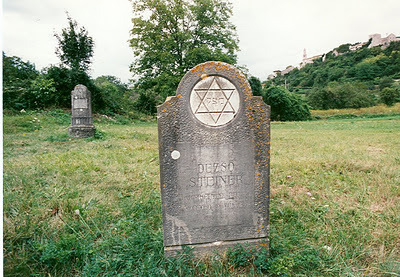 Stanjel gravestone. Photo (c) Ruth Ellen Gruber
Stanjel gravestone. Photo (c) Ruth Ellen GruberYesterday, Nov. 17, an exhibition dedicated to Jewish World War I soldiers opened in the former synagogue in Maribor, Slovenia. It is called Forgive Us, Forgive Us O You Dead. Jewish Soldiers of the Austria-Hungarian Army On The Isonzo Front.
In Isonzo Front, in northeast Italy and western Slovenia along the Isonzo river, is dotted with battlefields, museums and monuments to the World War I fallen. Some half a million soldiers died between 1915 and 1917. Fighting here was immortalized in Ernest Hemingway's novel A Farewell to Arms.
The exhibition in Maribor was curated by Petra Svoljšak, Head of the Milko Kos Historical Institute of the Scientific Research Center of the Slovenian Academy of Sciences and Arts, and Renato Podbersič, senior researcher at the SCNR (Slovenian Center for National Reconciliation).
The theme of the exhibition forms a part of the Podbersic's dissertation research, which is to be concluded in near future. Podbersic visit all the extant war cemeteries of WWI in Slovenia and added several other tombstones to the list that I had compiled in 1996. He made historical research of the documents and existing literature and also interviewed people who knew about Jews who fought on the side of the Austrian army in World War I.
Our friend Ivan Čerešnješ, of the Center for Jewish Art, contributed photos of his own grandfather and other Jewish soldiers from Bosnia, fighting in the Isonzo front.
Maribor Synagogue Center curator Janez Premk also advised on the exhibit. He said he believe that it will be "a major contribution in the contemporary research of the Jewish past in Slovenian lands."
Published on November 18, 2011 10:16
Ukraine -- Report on a Jewish Heritage Tour
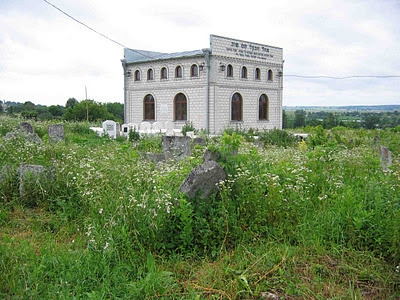 Ohel containing tomb of the Baal Shem Tov in Medzhybizh. Photo (c) Ruth Ellen Gruber
Ohel containing tomb of the Baal Shem Tov in Medzhybizh. Photo (c) Ruth Ellen GruberBy Ruth Ellen Gruber
As I am currently compiling up to date information on Jewish heritage sites in Ukraine and other European countries, I was pleased to come across an article by Yoram Dori, a senior advisor to Israeli President Shimon Peres, describing a Jewish heritage tour in Ukraine preceding participation in the Limmud cultural/educational event in Odessa. Dori traveled with Chaim Chesler, the founder and chair of the executive of Limmud FSU, Dan Brown, founder and editor of the eJewish Philanthropy website, Natan Roi, editor of the Jewish Agency's Hebrew website, and Edvard Doks, a travel guide and Ukrainian correspondent for Yediot Aharonot.
His article focuses on the fact that few if any of the Jewish heritage sites they visited bore mezuzahs or plaques or other signs indicating their history and origianl purpose -- and issues that has loomed large across former-Communist Europe since public interest in Jewish heritage began evolving in the late 1980s.
Ver is di mezuzah? ("Where is the mezuzah?") was the question at the heart of our tour of various Jewish sites in Ukraine, preceding the recent Limmud FSU festival in Odessa. [. . .]
For me, by the way, everything is clear. When I get home I will try to find a solution at least to the missing plaques. Maybe by an appeal to the president of Ukraine who is due to visit Israel shortly. To allow hundred years of Jewish history to disappear without trace is just not acceptable.
Their stops included Zhitomir, Berdichev, Vinnitsa, Medzhybizh, and Uman. (Except for Vinnitsa, I covered all these sites in Jewish Heritage Travel.)
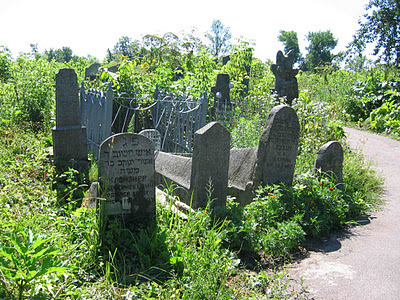 Jewish cemetery, Berdichev. Photo (c) Ruth Ellen Gruber
Jewish cemetery, Berdichev. Photo (c) Ruth Ellen Gruber
Published on November 18, 2011 05:46
November 17, 2011
Belarus -- Synagogue vandalized
[image error]File photo from Chabad.org
By Ruth Ellen Gruber
The synagogue in Babruysk in eastern Ukraine was vandalized twice in the past week.
The synagogue's secretary, Maya Savatseyeva, told RFE/RL that vandals smashed the synagogue's windows at about 2 a.m. on November 18. On November 11, a swastika and "Death to Jews!" was daubed on the fence surrounding the synagogue.
The town's Chabad-Lubavitch Rabbi Shaul Habobo said that the local government is providing security for the synagogue while the police continue to search for the perpetrators.
"Everything is pretty much repaired," he said. "Thank God, we have put this behind us."
The local Jewish community numbers about 50, mostly elderly, people.
By Ruth Ellen Gruber
The synagogue in Babruysk in eastern Ukraine was vandalized twice in the past week.
The synagogue's secretary, Maya Savatseyeva, told RFE/RL that vandals smashed the synagogue's windows at about 2 a.m. on November 18. On November 11, a swastika and "Death to Jews!" was daubed on the fence surrounding the synagogue.
The town's Chabad-Lubavitch Rabbi Shaul Habobo said that the local government is providing security for the synagogue while the police continue to search for the perpetrators.
"Everything is pretty much repaired," he said. "Thank God, we have put this behind us."
The local Jewish community numbers about 50, mostly elderly, people.
Published on November 17, 2011 02:10
November 12, 2011
England -- an "old Jewish quarter" tour in London
By Ruth Ellen Gruber
By now, "old Jewish quarter" tours in places like Prague, Venice and Krakow (or Boskovice, Trebic, even L'viv and beyond) are normal -- and popular -- niche itineraries. Here's a story in the London Jewish Chronicle about an old Jewish quarter tour in London's East End.......a district long the hub of Ashkenazi life in London that is now largely Asian.... but which I am old enough to remember when it was still at least something still of a Jewish district.....visiting the market in Petticoat Lane (and hearing about how Jewish it was) is a vivid memory from childhood.
The tour is offered by London Walks, a wellknown walking tour operation, which provides a video preview of the walk, which it describes as "set amid the alleys and back streets of colourful Spitalfields and Whitechapel ... a tale of synagogues and sweatshops, Sephardim and soup kitchens."
Here's some of what Monica Porter writes in the Jewish Chronicle:

By now, "old Jewish quarter" tours in places like Prague, Venice and Krakow (or Boskovice, Trebic, even L'viv and beyond) are normal -- and popular -- niche itineraries. Here's a story in the London Jewish Chronicle about an old Jewish quarter tour in London's East End.......a district long the hub of Ashkenazi life in London that is now largely Asian.... but which I am old enough to remember when it was still at least something still of a Jewish district.....visiting the market in Petticoat Lane (and hearing about how Jewish it was) is a vivid memory from childhood.
The tour is offered by London Walks, a wellknown walking tour operation, which provides a video preview of the walk, which it describes as "set amid the alleys and back streets of colourful Spitalfields and Whitechapel ... a tale of synagogues and sweatshops, Sephardim and soup kitchens."
Here's some of what Monica Porter writes in the Jewish Chronicle:
The highlight of the tour [is] a visit to the country's oldest surviving synagogue at Bevis Marks. [...]
Maurice Bitton, the shamash of Bevis Marks, welcomes us into the beautiful building, which dates from 1701. Tucked away in a courtyard, because Jews were not allowed to build on public thoroughfares at the time, it is virtually unchanged since it was built. The great brass hanging candelabra, austere dark oak benches, magnificent ark - everything is original.
Bitton recounts with relish the history of the Sephardi synagogue, and regales us with tales of the congregation's most famous son, the 19th-century philanthropist Sir Moses Montefiore. He shows us the great man's seat, now roped off. The congregation has shrunk since then, but Bitton says it is starting to grow again, as young Jews move back into the area.
For me, the visit brings back memories. In the 1970s, long before the City was redeveloped, I worked for a magazine whose creaky Dickensian offices overlooked this synagogue. On dusky winter evenings, I peered down through its windows into the warm, candlelit glow, mesmerised by the sound of chanting.
From here we walk north-east to Petticoat Lane (aka Middlesex Street), home of the shmutter trade. This is in Spitalfields, the beginning of the East End proper. Jews fleeing the pogroms in the late 19th century set up their stalls in the market here. Later, Alan Sugar, too, started life as a Petticoat Lane stallholder. Now it is abuzz with Asians, hawking shmutter of their own.
Published on November 12, 2011 03:07
Germany -- Travel story in Huffpost on Jewish sights in Worms
By Ruth Ellen Gruber
Worms, near Frankfurt in (western) Germany, is home to some of the most historic Jewish heritage sites in Europe -- the thousand-year-old Jewish cemetery (believed to be the oldest in Europe aside from ancient Roman-era catacombs) and the rebuilt 11th century Rashi synagogue with its museum. The synagogue was totally reconstructed from rubble between 1959 and 1961 -- one of the few synagogues of recognized historical importance in Europe that in the first three decades after World War II were reconstructed or restored in ways that retained their Jewish identity.
Alan Elsner reflected on his recent visit there for the Huffington Post.
Worms, near Frankfurt in (western) Germany, is home to some of the most historic Jewish heritage sites in Europe -- the thousand-year-old Jewish cemetery (believed to be the oldest in Europe aside from ancient Roman-era catacombs) and the rebuilt 11th century Rashi synagogue with its museum. The synagogue was totally reconstructed from rubble between 1959 and 1961 -- one of the few synagogues of recognized historical importance in Europe that in the first three decades after World War II were reconstructed or restored in ways that retained their Jewish identity.
Alan Elsner reflected on his recent visit there for the Huffington Post.
Published on November 12, 2011 02:46
November 11, 2011
Middle East Digital Jewish Heritage Tour -- Off Geographical Topic but Relevant
By Ruth Ellen Gruber
I want to highlight the Diarna project, a web site devoted to a digital tour of Mizrachi culture and Jewish heritage in the Middle East and North Africa. There are photographs, videos, descriptions and digital reconstructions of synagogues, etc.

I want to highlight the Diarna project, a web site devoted to a digital tour of Mizrachi culture and Jewish heritage in the Middle East and North Africa. There are photographs, videos, descriptions and digital reconstructions of synagogues, etc.
Border guards, plane tickets, and security concerns don't exist inside Diarna's unique digital tour. Instead, join a multimedia journey to the region's captivating yet rarely-visited Jewish heritage sites, from Saharan outposts in southern Morocco to remote Kurdish villages in Iran, to epic sites in the Arabian Peninsula.
Diarna, "Our Homes" in Judeo-Arabic, is a project dedicated to virtually preserving Mizrahi ("Eastern") Jewish history through the lens of physical location. Satellite imagery, photographs, videos, oral history, and even three-dimensional models offer a unique digital window onto sites and communities disappearing before our very eyes. As structures decay and the last generation to live in these locations passes on, we are in a race against time to preserve priceless cultural treasures.
Four ways to begin your journey: View Diarna's Media Gallery, including video tours of the Jewish cemetery in Khartoum, Sudan and the ancient synagogue in Oufrane, Morocco. Download a sample Diarna Google Earth tour layer, featuring sites in Egypt, Morocco, Saudi Arabia, Sudan, and Iraq. Make a Virtual Pilgramage to Moroccan Anti-Atlas Mountain ShrinesTour a 3-D Reconstruction of the Magen Avraham Synagogue in Beirut, Lebanon
Published on November 11, 2011 00:16
November 8, 2011
Italy -- Festival of Polish Jewish Culture in Venice
By Ruth Ellen Gruber
Later this month there will be a festival of Polish Jewish culture held in Venice -- with concerts, exhibitions, lectures, etc. I am scheduled to speak at the closing "Day of Study". The festival is organized by the Polish Institute of Culture in Rome, the Venice Jewish Community and the association organizing events for the upcoming 500th anniversary of the institution of the ghetto in Venice.
Here's the schedule (In Italian).

Later this month there will be a festival of Polish Jewish culture held in Venice -- with concerts, exhibitions, lectures, etc. I am scheduled to speak at the closing "Day of Study". The festival is organized by the Polish Institute of Culture in Rome, the Venice Jewish Community and the association organizing events for the upcoming 500th anniversary of the institution of the ghetto in Venice.
Here's the schedule (In Italian).
In occasione della presidenza polacca nel Consiglio dell'Unione Europea. Nell'imminenza delle celebrazioni per i 500 anni del Ghetto di Venezia. Venezia, dal 20 al 29 novembre 2011.Su proposta dell'Istituto Polacco di Roma e del suo direttore Jaroslaw Mikołajewski, la Comunità ebraica di Venezia e l'Associazione per i 500 anni del Ghetto di Venezia hanno voluto organizzare un Festival della Cultura Ebraica Polacca. Si tratta del primo evento culturale di un lungo percorso che condurrà nel 2016 alle grandi celebrazioni in occasione dei 500 anni dall'istituzione del Ghetto di Venezia, il primo ghetto al mondo. Gli organizzatori delle odierne manifestazioni hanno voluto dare particolare rilievo ai concetti di vita e di cultura, ! tentando di offrire al pubblico proposte culturali che spaziano cronologicamente dal '500 alla contemporaneità. Non è assente il tema della Shoah, che naturalmente trattandosi di ebrei e di Polonia non può essere trascurato, e tuttavia l'intento è quello di non farsi schiacciare dalla catastrofe dello sterminio e proporre ai visitatori tracce culturali spesso inesplorate e inedite. Gli ebrei e la Polonia nel passato e nel presente, con uno sguardo al futuro.
L'idea di organizzare questo evento a Venezia assume particolare significato per la collocazione geografica e storica della comunità ebraica lagunare in rapporto alla Polonia. Basterà pensare agli importanti rapporti culturali e famigliari fra esponenti del rabbinato veneto e polacco a partire dal Cinquecento, ed è utile ricordare che all'indomani del rogo del Talmud (1553) che mise fine alla stampa a Venezia della principale opera della tradizione ebraica, il testimone venne preso dagli stampatori di Cracovia che produssero la loro prima edizione già nel 1559. E da Venezia provennero gli ebrei (sefarditi) che andarono a fondare la comunità ebraica nella lontana Zamosc, nuova città costruita da un architetto padovano e disegnata sul modello rinascimentale.
Il Festival prevede i seguenti appuntamenti:
- Una mostra sui rabbini di Cracovia presso il Museo Ebraico! di Venezia
- Un dibattito sul rapporto fra ebrei e Polonia con la partecipazione di Adam Michnik, intellettuale ebreo polacco, giornalista, protagonista della rinascita democratica e animatore del movimento Solidarnosc.
- Un evento "concerto e parole" con il decano dei musicisti klezmer di Polonia, Leopold Kozlowski
- Una rassegna cinematografica dedicata allo sguardo del grande regista polacco Andrej Wajda sul rapporto fra ebrei e Polonia.
- Una Giornata di Studi incentrata sulle dinamiche insediative degli ebrei fra Venezia e l'Europa orientale.
In particolar! e la Giornata di Studi rappresenta l' evento iniziale del lungo percorso di valorizzazione della storia del Ghetto di Venezia e dei suoi 500 anni.
Programma
20 novembre
Rabbini di Cracovia – ore 16, inaugurazione della mostra presso il Museo Ebraico
Ebrei-polacchi, polacchi ed ebrei: riflessioni su una storia comune – ore 17-19 presso la Sala Montefiore (Cannaregio 1189) Tavola rotonda con Adam Michnik, Francesco M. Cataluccio, Laura Mincer
Leopold Kozlowski, l'ultimo klezmer della Galizia – ore 20 presso la sala concerti del Conservatorio Benedetto Marcello, Palazzo Pisani, San Marco 2810, concerto di musica e parole.
22 – 29 novembre
Ho sentito la voce del dottor Korczak – rassegna cinematografica dedicata ad Andrej Wajda e al suo sguardo sull'ebraismo polacco. La rassegna si svolge presso la Casa del Cinema.
Martedì 22 novembre : ore 17.30 GENERAZIONE (Pokolenie, 1955) di Andrzej Wajda; ore 20.30 SANSONE (Samson, 1961) di Andrzej Wajda
Giovedì24 novembre : ore 17.30 PAESAGGIO DOPO LA BATTAGLIA (Krajobraz po bitwie, 1971) di Andrzej Wajda; ore 20.30 DOTTOR KORCZAK (Korczak, 1991) di Andrzej Wajda
Martedì 29 novembre : ore 17.30 SETTIMANA SANTA (Wielki tydzien, 1995) di Andrzej Wajda;
ore 20.30 DYBBUK (Der Dibuk, 1937) di Michal Waszynski
27 Novembre
Ore 10-18 Giornata di Studi: LA CITTÀ DEGLI EBREI: GHETTI, QUARTIERI, SHTETL FRA PASSATO E PRESENTE
Published on November 08, 2011 22:54



